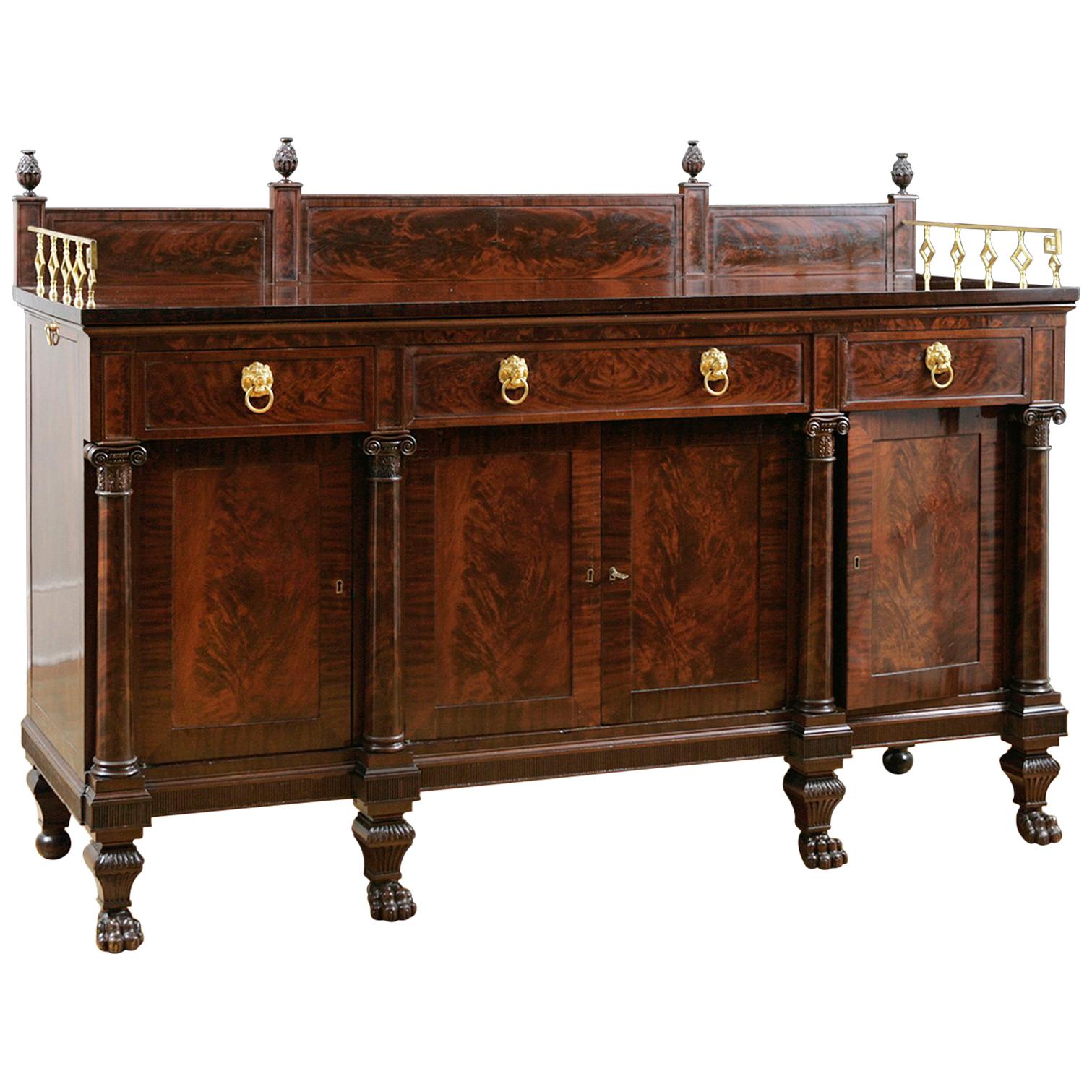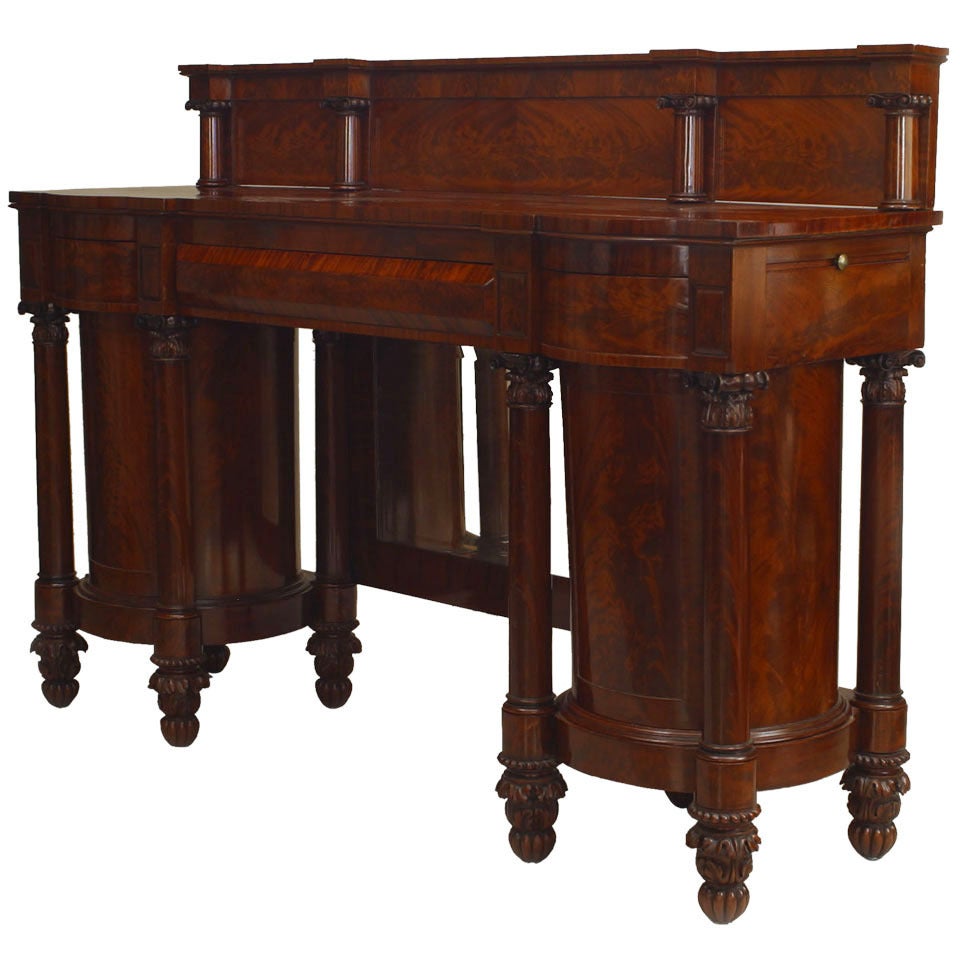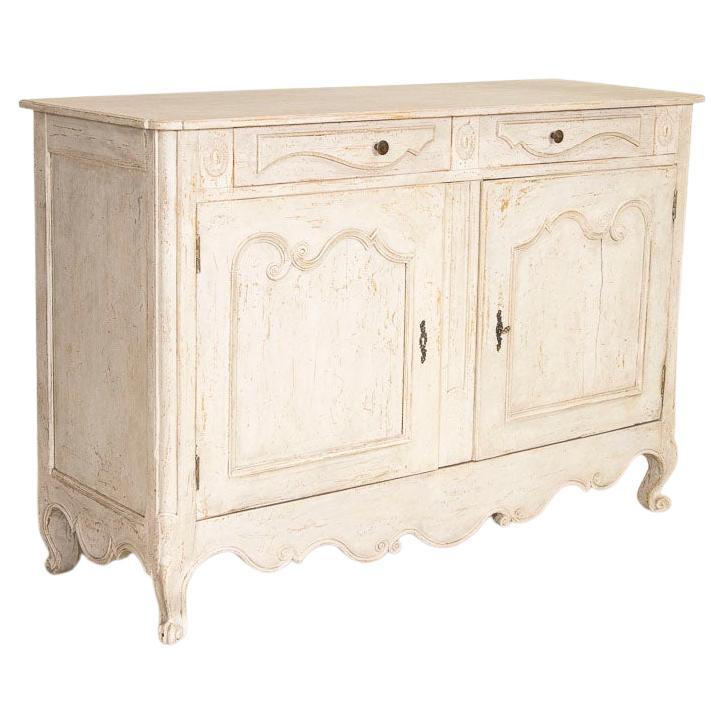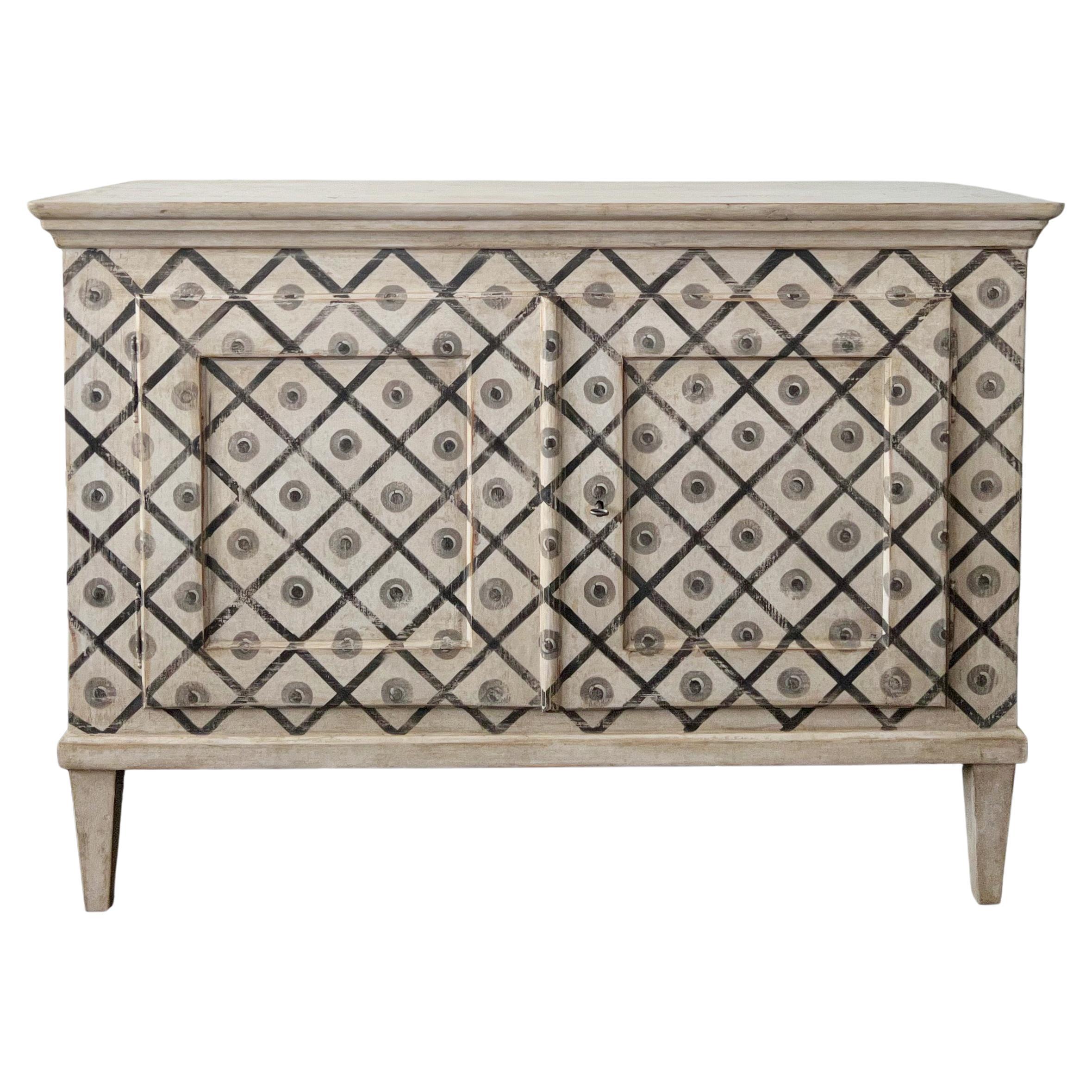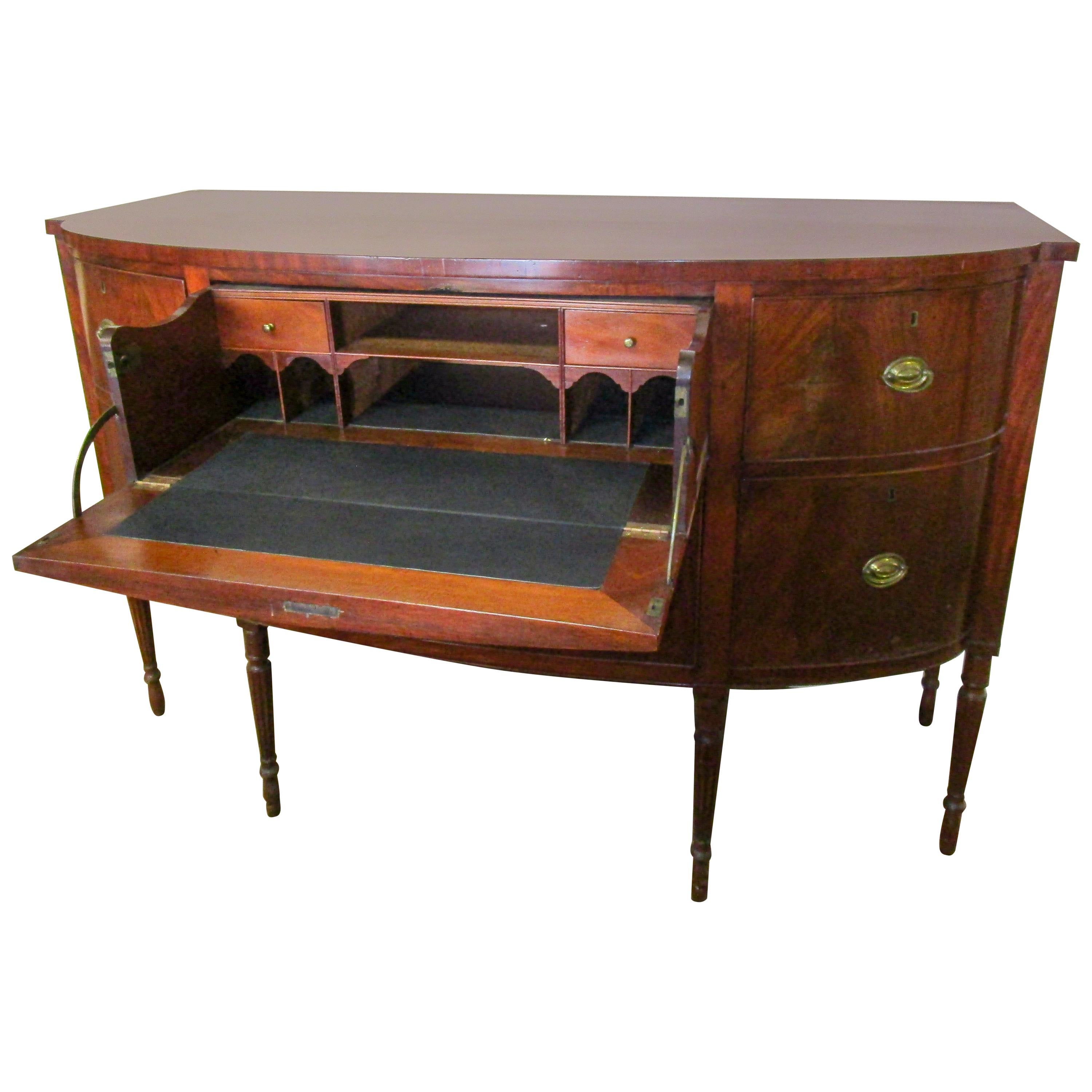Items Similar to Early 19th Century American Sheraton Sideboard Attributable to Duncan Phyfe
Want more images or videos?
Request additional images or videos from the seller
1 of 21
Early 19th Century American Sheraton Sideboard Attributable to Duncan Phyfe
About the Item
We have the pleasure to present to you a stunning early 19th century American Sheraton Sideboard by Duncan Phyfe.
Made circa 1810 in New York.
Though unsigned, we have no hesitation in attributing this piece to Duncan (Fife) Phyfe.
It is of exceptional construction, craftsmanship and style to identify it as a piece of American Sheraton. The combination of woods and veneers tells us this also. The front is mahogany veneer with satinwood herringbone stringing and satinwood/tulipwood escutcheons. The secondary woods are walnut, cheery and birch.
The identifying factor tying this to the famous maker Duncan Phyfe are the brass handles. They are 4 of them to the front and they are original to the piece. They are fixed on 3 frontal drawers and are of exceptional quality and casting. They depict the Scottish Thistle for Phyfe’s homeland of Scotland and have appeared on other pieces by Phyfe.
It also has 2 swinging doors on either side which open to reveal shelving and the 2 central doors likewise.
The front is serpentine in shape and form with each door of a convex nature.
It sits on 8 fluted and graduating legs with the front 4 reflecting the satinwood stringing and banding of the upper portion.
We recently had some of the locks serviced (and keys made) by a professional locksmith who informed us that the locks were original early 19th Century American locks and he has rarely seen others like them. This again, helps us in authenticating the piece !
THIS IS A GORGEOUS and ORIGINAL PIECE OF EARLY AMERICAN FURNITURE BY A FAMOUS MAKER
IT IS ALSO FROM A PERIOD WHERE PHYFE’S CAREER WAS JUST TAKING OFF IN NEW YORK AND IS MUCH MORE DESIRABLE THAN HIS LATER PIECES !
Duncan Phyfe (1768 – 16 August 1854) was one of nineteenth-century America’s leading cabinetmakers.
Although he did not create any new furniture style, he interpreted fashionable European trends in a manner so distinguished and particular that he became a major spokesman for Neoclassicism in the United States, influencing a whole generation of American cabinetmakers.
Born Duncan Fife near Loch Fannich, Scotland, he immigrated with his family to Albany, New York, in 1784 and served as a cabinetmaker’s apprentice.
In 1791 he moved to New York City and one year later is documented the earliest mention of him in the city, when he was elected to the General Society of Mechanics and Tradesmen, sponsored by Isaac Nichols and Seabury Champlin, either of whom may have trained him.
By the time of his marriage in 1793, he appears in the New York directories as a “joiner,” but by 1794 he called himself “cabinetmaker” and had changed the spelling of his name to Phyfe. He opened his own business in 1794 and was listed as a cabinetmaker in the New York Directory and Register. From his first shop on 2 Broad Street, he later moved to Partition Street (later renamed Fulton Street in 1817 in honor of Robert Fulton), where he stayed for the rest of his life.
A poor immigrant when he arrived in America from his native Scotland, Phyfe acquired wealth and fame through hard work, exceptional talent and the support of patrons. He would come to count among his clients some of the nation’s wealthiest and most storied families. Throughout the first half of the nineteenth century he made Neoclassical furniture for the social and mercantile elite of New York, Philadelphia, and the American South where he was particularly popular. Known during his lifetime as the “United States Rage”, to this day remains America’s best-known cabinetmaker. Establishing his reputation as a purveyor of luxury by designing high-quality furniture.
His personal style, characterized by superior proportions, balance, symmetry, and restraint, became the New York local style. Many apprentices and journeymen exposed to this distinctive style by serving a stint in the Phyfe shop or by copying the master cabinetmaker’s designs helped to create and sustain this local school of cabinetmaking. Demand for Phyfe’s work reached its peak between 1805 and 1820, although he remained a dominant figure in the trade until 1847, when he retired at the age of seventy-seven. Within the short span of a single generation, however, the work of the master was all but forgotten until the revival in the 1920s, when different furniture companies replicated his designs for several decades.
He became known as one of America’s leading cabinetmakers by selling furniture at relatively low prices. Phyfe’s work encompassed a broad range of the period’s Neoclassical styles, starting from his earliest furnitures— which bear the influence of his 18th-century British predecessors Thomas Sheraton and Thomas Hope— continuing with Regency, Federal, Empire and ending with his late simplified designs in the Grecian plain style.
On 15 October 1922, the Metropolitan Museum of Art opened to the public “Furniture from the Workshop of Duncan Phyfe”, the first exhibition ever held in an art museum on the work of a single cabinetmaker. Ninety years later and only for the second time in history, a major retrospective on this iconic American craftsman and his furniture was again on view from 20 December 2011 – 6 May 2012, under the title “Duncan Phyfe: Master Cabinetmaker in New York”.
Another exhibition took place at the Museum of Fine Arts, Houston from 24 June – 9 September 2012.
Duncan Phyfe’s furniture can be admired in the White House Green Room, Edgewater, Roper House and especially at Millford Plantation, owned by the Classical American Homes Preservation Trust. His furniture appears in many museums and private collections as well.
- Attributed to:Duncan Phyfe (Cabinetmaker)
- Dimensions:Height: 41.2 in (104.65 cm)Width: 68.75 in (174.63 cm)Depth: 24.25 in (61.6 cm)
- Style:Sheraton (Of the Period)
- Materials and Techniques:
- Place of Origin:
- Period:
- Date of Manufacture:1810
- Condition:Wear consistent with age and use. Minor losses. Very good for it’s age. Some minor losses of veneer (chips) but nothing serious. 2 of the internal base shelves are replacements. Has keys. Crack on the top, but does not detract from the piece.
- Seller Location:Dallas, TX
- Reference Number:1stDibs: LU3978122123752
About the Seller
4.9
Gold Seller
These expertly vetted sellers are highly rated and consistently exceed customer expectations.
Established in 2015
1stDibs seller since 2018
349 sales on 1stDibs
Typical response time: <1 hour
- ShippingRetrieving quote...Ships From: Dallas, TX
- Return PolicyA return for this item may be initiated within 7 days of delivery.
More From This SellerView All
- Early 19th Century English Chiffonier in the Manner of GillowsBy Gillows of Lancaster & LondonLocated in Dallas, TXPresenting an absolutely gorgeous early 19th century English chiffonier or breakfast buffet, most likely, from the renowned maker of Gillows of Lancas...Category
Antique Early 19th Century English Regency Buffets
MaterialsBrass
- Art Deco Portois and Fix Viennese Buffet SideboardBy Portois & FixLocated in Dallas, TXPresenting an amazingly rare piece of Art Deco furniture by an exceptionally rare maker, namely, an Art Deco Portois and Fix Viennese buffet sideboard. Part of a complete Dining Room Set comprising of 3 pieces – this Buffet/Sideboard, Tall Case Clock ands Credenza. All in our Inventory but being sold separately (or together if you have a desire to own the complete set which you will NEVER be in a position to do again). Made in Vienna, Austria circa 1920-30 by the famous furniture maker of Portois & Fix. The piece consists of a Buffet or Sideboard with glass display pillars...Category
Early 20th Century Austrian Art Deco Sideboards
MaterialsBrass
- Early 19th Century American Sheraton Tilt-Top Table of Neat ProportionsLocated in Dallas, TXPRESENTING a GORGEOUS Early 19C American Sheraton Tilt top Table of very desirable neat proportions. Made in America, possibly New York or New England, circa 1800. Made of Walnut, cherrywood and satinwood. The table is diamond in shape and the turned tripod base and feet appear to be made of walnut. The feet have beautifully simple, pointed toe feet …. ‘classic’ examples of ‘period’ American side tables of this Era! The square platform, attaching to the top to the base, has a brass catch/latch insert, with a ‘period’ brass button clasp on the underside of the table top, for the tilting mechanism. The square table top, itself, appears to be mainly cherry wood for the central square section, which in turn is then encased in a walnut square border and edged with a beautifully patinated striped satinwood. The central diamond on the table top is likewise a striped/burl satinwood of very high quality, edged with boxwood. There is a visible crack on the top and it appears that at some stage in its history, someone turned the table top 90 degrees, so that the baton supports underneath would support the weakened section with the crack. We have no doubt, however, that the top is original to the base and not a ‘marriage’, as the line (as one can see in the photos) on the base of the top where the batons were previously located perfectly matches the existing batons. The table is very ‘stable’ but the top (once locked in the down position) has a very slight lean towards the repaired cracked section. This is not significant and does not detract from the beauty and utility of this piece. We have, however, reflected these repairs, etc. in our pricing. It is also obvious, that the table was ‘always’ diamond shaped. It is the use of the cherry and walnut, coupled with the toe feet, that tells us, that this is ‘unmistakably’ an American Sheraton piece. Provenance: From an Outstanding Private Dallas Collection. Condition: Very good. See the full listing (above) for more detail on minor defects. Dimensions: 26.75 inches tall with top down, The table top is 17.2 inches x 17.8 inches With the top tilted it is 39.25 inches Tall and has a depth/width at the feet of 19.75 inches. Sheraton is a late 18th century neoclassical English furniture...Category
Antique Early 19th Century American Sheraton Side Tables
MaterialsCherry, Satinwood, Walnut
- 18th Century Irish Georgian Cork SideboardLocated in Dallas, TXPresenting a gorgeous and very rare 18th century Irish Georgian Cork Sideboard of lovely neat proportions. Made in Ireland during the George III Era, circa 1790 and most likely made in the Southern City of Cork. A STUNNING Irish provincial piece from the Georgian Era! Made of solid mahogany, probably imported from Cuba and the secondary woods are oak (as one would expect). Beautiful dovetailing on the inside of the drawers. The ‘hints’ that this is in fact an ‘Irish’ piece are numerous. The ‘scallop shell’ on the center of the back gallery is unmistakably an Irish Georgian signature. The scalloped fans beneath either side of the central drawer are likewise an Irish signal. The shape, design and style is entirely consistent with similar pieces made in Cork at the end of the 18th Century. It has it’s original brasses which is fantastic. Lions Head Ring drawer pulls and stunning urn keyhole covers/escutheons. It has a solid gallery back splat (with central Scallop) and on both sides this ends in curved and carved scroll ends. Beneath the back splat their is a grooved plank section for holding plates etc upright. The server/counter top area is edged and banded with a carved rope style edging. The mid section consists of 3 drawers and 2 doors. The piece sits on 6 legs 4 to the front and 2 to the rear. The front legs are pillars starting at the top with an acanthus style scroll … extending down to another scroll carving directly above the reeded and fluted legs. The 2 rear legs do not have the same fluting detail. The 2 side doors open to reveal a simple one shelf storage area. One probably held a lead lined cellarette at one time. The piece is in excellent condition for it’s age and use. There are some minor aging cracks on the counter top on the left hand side. A small loss of molding to the right lower door. No original keys but we are getting replacements made. Bought in Surrey, England in 1999 by a Private Texas Collector and shipped to Texas. We have the original ‘sales invoice’ and the dealer sold it as a “Regency Mahogany Sideboard circa 1820’and told her that it was an English piece, for the sum of 3,400 GBP. Not only did the dealer not recognize the obvious ‘Irish’ signs...Category
Antique Late 18th Century Irish George III Buffets
MaterialsMahogany, Oak
- Early 20C Exceptional Chippendale Irish Georgian Style Sideboard by S HilleBy Salomon HilleLocated in Dallas, TXPresenting an amazing early 20th century Exceptional Chippendale Irish Georgian style sideboard by Salamon Hille. This piece is simply Magnif...Category
Early 20th Century English Chippendale Buffets
MaterialsMahogany
- Early 19th Century American Cherry Extendable Dining TableLocated in Dallas, TXPresenting a stunning early 19th century American cherry extendable dining table. From circa 1800-1820 and made of solid cherrywood. T...Category
Antique Early 19th Century American Federal Dining Room Tables
MaterialsCherry
You May Also Like
- American "French Sideboard" Attributable to Duncan Phyfe, New York, circa 1815By Duncan PhyfeLocated in Miami, FLAn exceptionally fine and rare "French Sideboard Table" in mahogany, attributable to the workshop of the eminent New York cabinetmaker, Duncan Phyfe, circa 1810-1818. This exquisit...Category
Antique Early 19th Century American Federal Sideboards
MaterialsBrass
- Duncan Phyfe American Empire Mahogany SideboardBy Duncan PhyfeLocated in New York, NYAmerican Empire mahogany sideboard with two pedestal cabinets and 4 carved column supports centering a lower mirror under 3 drawers ...Category
Antique Late 18th Century American Empire Sideboards
MaterialsMahogany, Mirror
- Early 19th Century French Sideboard Buffet Painted WhiteLocated in Round Top, TXThis delightful sideboard has been given a white painted finish, adding to its charming French country style. The paint has been gently distressed revealing the natual wood below, so...Category
Antique Early 19th Century French Buffets
MaterialsWood, Paint
- 19th Century Painted SideboardLocated in Charleston, SC19th century, Louis XVI style two paneled door sideboard in later whimsical refinish diamond-shaped painting with dot decoration on a gray background on...Category
Antique 19th Century French Buffets
MaterialsWood, Paint
- Early 19th Century Sheraton Style American Bowfront Sideboard with Dropdown DeskBy Thomas SheratonLocated in Savannah, GAIn fifty-two years in business we have never seen a piece like this rare bowfront sideboard with a top drawer that folds out to reveal a writing surface with leather top. Other feat...Category
Antique 1810s American Sheraton Desks
MaterialsBrass
- 19th Century French Provincial SideboardLocated in Sheffield, MA19th century Louis XV French painted buffet server. Can be used in a Swedish Gustavian setting as well. Light grey wash finish, brass handles, pewter knob...Category
Antique 19th Century French Gustavian Buffets
MaterialsOak, Paint
Recently Viewed
View AllMore Ways To Browse
Antique New Furniture
New Antique Furniture
Antique Furniture Company
Furniture To Sell
Selling Used Furnitures
Selling Used Furniture
19th Century Early American Furniture
Selling Antique Furniture
Early American Period Furniture
Antique American Furniture Makers
American Antique Furniture Makers
Early American Furniture Mahogany
Classical American Design
American Craftsman Style
Used Duncan Furniture
18th Century Sheraton Furniture
18th Century Sheraton
Shelving 19th
